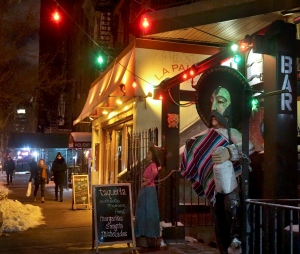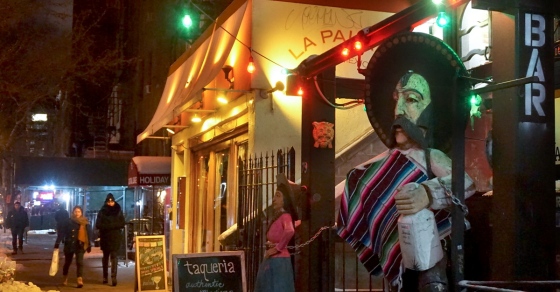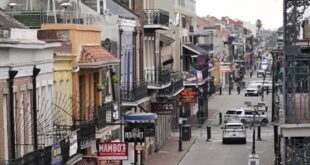
Early on a mild September morning, an elderly man on a black bicycle meanders along the paths of Tompkins Square Park, in New York’s East Village. A cassette tape player balanced on the bicycle’s crossbar plays tinny Asian music that grows louder as he approaches and then fainter as he pedals away. The only other sound is birdsong.
I stop to sniff some drooping, blowsy roses. I crouch to read the inscriptions on the cobblestones: “Blake Schaefer — One helluva guy.” “Steven Vincent — He loved this park.” “In loving memory of Demko (the dog).”
I watch a group of women doing tai chi on the grass, the early sun lighting their faces, making them glow.
Outside the park fence, on the sidewalk, folks are setting up tables for a farmers market. I buy a guava pie and eat it as I walk back to my hotel on St. Marks Place.
What a lovely place, I think. So peaceful. So hidden. So unknown.
Clearly, I do not know what I am talking about. Clearly, I do not know a thing.
St. Marks Place, as it turned out, might be the most famous street in all of New York City — outside of Broadway, I guess, and maybe Fifth Avenue. It is very short. It starts at Astor Place and ends three blocks later at Tompkins Square Park. But just about everyone has lived along those three blocks, or has loved, fought, joined a band, planned a revolution, written a poem, danced all night, dropped acid, eaten tacos, gotten drunk, sold something on the sidewalk or crashed on somebody’s couch here.
You want names? Emma Goldman, Andy Warhol, Charlie Parker, Al Capone, W.H. Auden, Patti Smith, Norman Mailer, Jack London, Leon Trotsky, Debbie Harry, James Fenimore Cooper, Thelonious Monk, Jackie Kennedy, Leonard Bernstein, Allen Ginsberg, the Ramones. There are more. Abbie Hoffman used to invite the neighbors over to watch TV here.
The street has been immortalized on album covers and in music, movies, videos, TV shows, poems and novels. Lou Reed wrote a song about it. Ada Calhoun wrote a book about it. Lena Dunham set an entire episode of Girls here.
How can it be that I had never heard of it?
I had not been to New York in nearly 20 years when, suddenly, work brought me there three times last year, and three times again this year. My meetings were all in the East Village, at New York University and the New School. I wasn’t sure where they were, could not remember how to use the subway, had no idea where to stay.
A friend suggested an inexpensive hotel right around the corner from NYU: St. Marks Hotel. “It’s very basic,” she warned. “No refrigerator. No elevator. No doorman! Though the really nice person at the desk has been there for years.”
It was only $110 a night — cash only.
My room in St. Marks Hotel was up four steep flights and so tiny that it held only two things: a bed, and a straight-back chair. But the window opened onto the exciting noise of honking cabs and shouting pedestrians, the room was scrupulously clean, and I had free Wi-Fi.
My first night there, I walked down the many stairs, out the hotel’s front door, turned right, and, bam! I was in Funkytown.
Immigrants, then radicals
St. Marks Place is a typical narrow East Village street, lined with tall brick and stone buildings, some with fire escapes and wrought-iron railings along the front stoops. Festive white lights are twined in branches, or strung from doorways to trees.
The street was settled in the early 1800s by immigrants — well-to-do Germans, followed by Jews, Italians, Poles and Ukrainians. Due in part to its proximity to NYU and Cooper Union, St. Marks Place became a hotbed of communism, and that counterculture vibe has continued. The street has been home to beatniks and anarchists and hippies and drag queens and punk rockers. Everything, it seems, happened here first. Journalist Ada Calhoun grew up on St. Marks Place, and as she writes in her excellent book, St. Marks Is Dead: The Many Lives of America’s Hippest Street, everyone who has ever hung out there has believed that their time on St. Marks was the hippest. She quotes writer Malcolm Cowley: “Bohemia is always yesterday.”
But as I walked along the street, it still looked pretty Bohemian to me.
There were storefronts at ground level, apartments above, leafy trees along the sidewalks, people everywhere day and night (but mostly night) selling things, arguing, laughing, plotting their tattoos (“They’re only $13,” I heard one girl say), walking their dogs, sleeping in stairwells or on the bench outside of the flag-festooned St. Dymphna’s Irish bar.
Many of the lampposts sparkled in their own light; over the years, more than 60 lamp poles along St. Marks and elsewhere in the East Village have been decorated with elaborate mosaics by Jim Powers, a white-haired veteran who came back from Vietnam with PTSD and found making public art out of tiny bits of glass, ceramic, mirrors and coins to be therapeutic.
That first night I walked through a cloud of pot smoke, past some immigrants who were selling hats and sunglasses on the sidewalk, past a tattoo parlor; a comic book store; a barbershop; two or three small theaters; a used bookstore with a tin ceiling; a Mexican taqueria; a noisy Irish bar; another noisy Irish bar; a couple of bakeries; a workout place; Gem Spa, the venerable newsstand that invented the egg cream; and Crif Dogs, a hot dog joint with an impressive giant hot dog jutting out above the door, “eat me” written on it in mustard-colored paint.
A young woman smoking a cigarette on a stoop watched me take a photo. “That will be good picture,” she said in a Russian accent, and I could not tell if she was being sardonic. “A hot dog.”
I walked up and down those three blocks, up and down, up and down. A parade of people silently glided past wearing antlers and white-faced masks. I wanted to follow them, but they looked so magical and mysterious I just stood and watched them go.
Not a secret at all
After my first stay on St. Marks Place, I told my family and friends about my find.
They all knew about it already.
My brother used to hang out on St. Marks Place when he lived in New York in the 1970s; he felt it had been cleaned up enough in recent years to bring his daughters there two years ago.
A friend told me that he used to go to Wigstock, the huge end-of-summer drag festival held in Tompkins Square Park in the 1980s. Another friend wrote, “I was at St. Marks back in the ’80s — they used to sell yard-sale type stuff on carpets.” (“Still do!” I thought.)
Mysterious phone booth
There are more than 60 places to eat along St. Marks Place — yuppie places with craft beer and complicated cocktails, as well as inexpensive ethnic restaurants with sushi, lamb burgers, tortillas, falafel, Chinese dumplings, potato pancakes, ice cream.
Papaya King — its name lit up in cheerful neon — was right across the street from my hotel, a colourful beacon that told me I was almost home. It sells the best hot dogs in New York — so says Julia Child, her words on the front window, also in neon. But it was my plan to visit Crif Dogs — the place with the “eat me” wiener — because Crif Dogs has a secret.
It’s a classic hot dog joint, down five steps from street level, with a wooden floor, a low ceiling, orange-red vinyl chairs, an old retro phone booth. A New York friend clued me in on the secret: On the other side of the wall is an old speakeasy. To get in you must enter the phone booth, lift the receiver, press a button. The wall of the phone booth will open.
This sounded cooler than anything, and so on St. Patrick’s Day, chased out of St. Dymphna’s bar by the over-loud thumping of the Pogues, I dragged some friends across the street to Crif Dogs. But we were stymied. Two people had parked their orange-red vinyl chairs squarely in front of the phone booth, and they were not about to budge. “Do you have a reservation?” one of them demanded.
We did not. It had not occurred to me that we would need a reservation for a secret bar inside of a phone booth.
Back to the park
The serene Tompkins Square Park that I strolled through on that September morning might be sedate these days, but that has not always been true. For decades, the park was the political heart of the Village, home to protests, homeless camps, riots and demonstrations. In 1874 more than 7,000 people filled the park, protesting unemployment, and they were routed by 1,600 policemen riding horseback and swinging billy clubs.
In 1966, followers of Hare Krishna gathered under a spreading elm tree in the park and held the first outdoor chanting session outside of India, dancing and shaking their tambourines. That moment marked the birth of the Hare Krishna religion in the United States; the elm tree is forever known as the Krishna Tree.
In the 1980s, the park was overrun with tent cities and homeless people for years until August 1988, when the police moved in, again with billy clubs. The ensuing riot lasted until dawn and saw hundreds of people injured, the tent city trampled to dirt.
Things are tamer now. The park is the site of an annual Halloween costume parade for dogs. How times change! Bohemia was yesterday.
Did I know any of this on that first morning? No. I was smelling the roses, eating a guava pie and watching a man with a radio cycle past me in loopy, wavering circles. I was thinking that I had happened upon the most peaceful spot in all of New York City.
Laurie Hertzel is the senior editor for books at the Star Tribune.
[ad_2]You can read more of the news on source
 Travelsmart
Travelsmart



